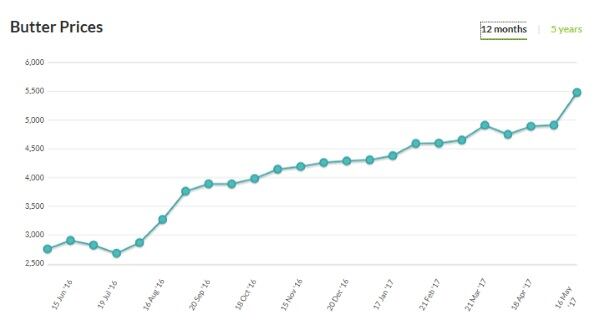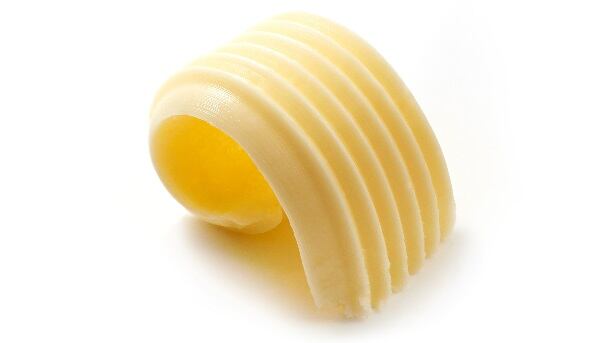The cost of butter has reached record highs in the past 12 months, crossing the €400/100kg ($449.89/100kg) threshold in October, the first time that level has been reached since 2013.
Butter has reportedly almost doubled in the UK and, according to Les Federation des Pain Entrepreneurs de la Boulangerie L’Avirnir (FEB), rocketed as much as 90% in the EU in the past year.
Consumers ‘butter’ get ready for price rise
This has raised concern by the FEB of the economic repercussions that could affect French BVP (Boulangerie-Viennoiserie-Pâtisserie) companies.
The FEB, which represents 38,000 employees in France with a €8.5bn ($9.56bn) turnover – including €2bn ($2.25bn) in exports, said if the cost continues to soar, it could have the domino effect of being passed on to consumers.
“Butter is the main element, indispensable even, in most recipes of the products of the sector,” reported the French bakery association.
According to Alan Clarke, CE of Scottish Bakers, the rising price of butter is having a major impact on the sector, and particularly those who export their products.
“This is affecting the sector, mostly our export members who use significant quantities in shortbread production,” he told BakeryandSnacks.
“Some have already passed on increases from last year to their customers but are now having once again to re-evaluate and realign prices in order to at least maintain margins but also meet customer expectations,” added Clarke.
Sergey Avramenko, head of Global Markets Research Team at IndexBox told this site that the rise in butter prices depends on the state of the dairy industry in multiple countries.
"The increase in the price of basic raw materials – namely milk – appears as the key factor contributing to the rise in the price of butter. The increase in milk prices is due to the poor growth of dairy cattle stock, on average, worldwide, and the decrease in the number of livestock in the EU; and the decline of milk production in Uruguay, Argentina and Australia, due to poor weather conditions.
"Should butter prices increase, the net cost of the end product in the bakery and pastry industry will also increases" he said.
"Bakery and pastry manufacturers are working towards reducing the net cost of the end product by using cheaper alternatives to butter in their production methods, such as margarine and spreads. The increase in the net cost means that many producers are beginning to enhance the efficiency of their production lines to maintain product quality, or they are moving to cheaper product segments," added Avramenko.
He purports that most commercial bakery items use margarine, so the rise in the price of bakery products may not appear "as" noticeable.
"The rise in butter prices will be mostly felt where butter is used, such as in the upper price segment. Increasing the net cost makes bakery and confectionary manfacturers either increase prices or turn to using cheaper vegetable oil alternatives to butter, which then can make a negative impact on the positioning of the end product," he said.
Bad news for home bakers
Ali Loughlin, analyst at Kantar Worldpanel, said that costs began to creep up following a two-year period of falling prices in the butter market.
“In the 12 weeks to April 23, we’ve seen price hikes really accelerate: the average cost of butter now stands at £4.95 per kilo – a rise of almost 17%.
“Traditionally on the more expensive side, spreadable no longer commands the price premium over block butter it once held. The average price of block butter has risen by more than a quarter – almost double the rate of its spreadable counterpart, which is particularly bad news for home bakers,” said Loughlin.

Price rise reasons
Global Dairy Trade (GDT), owned by Fonterra Cooperative Group (although operationally and physically separate from the dairy producers), sets credible reference prices for globally traded dairy ingredients.
According to numerous market reports, the Farmgate Milk Price was too low, so production was reduced to drive the price up.
This caused a rise in dairy cow slaughtering for beef production to allow farmers to make ends meet. It also resulted in lower milk fat availability.
The increase in demand from China, the Middle East and North Africa is also attributed to tight domestic milk supplies, while the UK’s decision to leave the EU has resulted in rising inflation, too.
“We’ve recently seen a return to inflation in the grocery market so prices are up across the board. However, inflation in the broader market stands at 2.6% - a fraction of the rate at which the price of butter has risen,” said Kantar’s Loughlin.
So, what’s behind these rocketing butter prices?
“A closer look at the dynamic between own-label and branded butter sheds some light on the trend,” she explained.
“For almost five years, the price of own-label butter was in slow but steady decline, falling from £4.79 ($6.21) per kilo in mid-2012 to £3.41 ($4.42) per kilo in May last year. Branded butter saw prices drop, too, but not to the same extent. Over the past year, prices of private label block butter have jumped by almost a third, bringing the average price to £4.62 ($5.99) per kilo,” she said.
Levelling the playing field
Butter intervention

Intervention schemes help to stabilize the price of products. Products are bought by the EU/UK government when prices are low and supplies are high, removing surpluses from the market.
The schemes can be seasonal or in response to exceptional market conditions, as in the butter situation.
From March to August, intervention purchasing for butter held in storage in Ireland (under Commission Regulations (EC) 1272/2009 (doc 60Kb) is triggered when the market price falls below 92% of the butter intervention price for two weeks in succession.
Butter is then bought at 90% of the intervention price.
Buying-in will cease once the quantities offered exceed 30,000 tons.
Loughlin contended that, despite the sharp rise, today’s prices are lower than they were five years ago.
“This suggests this is a more a return to normal pricing, levelling the playing field between branded and own label,” she said.
“Another trend that has contributed to higher average prices is reduced promotional activity as supermarkets switch to everyday low pricing.”
“The proportion of butter that went through on promotion fell by 23% last year, with block butter particularly affected. However, this isn’t deterring shoppers from adding the everyday staple to their baskets with volume sales remaining fairly flat,” she added.
Better butter awareness
Another reason for the increase in demand for butter is a change in mindset.
“Many dairy councils, organizations and companies are using recent scientific research that says butter isn’t as bad as it was made out to be,” Jim Cornall, editor of sister publication DairyReporter told this site.
“While ‘everything in moderation’ is still good advice, and the science suggests it’s not a black-and-white issue, many consumers are being swayed by the natural message of butter, and by its clean-label attributes,” he said.
Loughlin agreed: “The trend for more natural, less processed products has led many Brits to move away from margarine and other low-fat alternatives – butter is no longer viewed as wholly ‘bad for you’, but rather part of healthy balanced diet.”
Mike Kruiniger, research associate at Euromonitor International, concurred that the image of butter has indeed changed in the past few years.
“Butter is very much benefitting from the trend towards more natural products; consumers are becoming increasingly weary of processed foods and products that claim unrealistic health benefits,” he said.
“As a result, they opt for more natural products as they believe that these are generally healthier. In addition to the healthier image of butter compared to processed products (e.g. margarine), butter has also benefitted from the home baking trend generated by shows such as the Great British Bake Off, and the fact that butter is seen as a more indulgent option.”
Kruinger agrees with FEB’s prediction that increased costs incurred in production will have to be absorbed by either manufactures, retailers or consumers.
“The specific dynamics will have to be negotiated between the former two,” he said.
Unchanging scenario
Regarding the future, Euromonitor’s Kruinger commented: “With political and economic uncertainty continuing due to Brexit negotiations, it is likely that sterling remains relatively low.
“As a result, increased butter exports from the UK are foreseen to continue throughout 2017 and 2018, notwithstanding any exceptional circumstances arising from difficulties in the Brexit negotiation process.”
“Additionally, the price of butter is dependent on milk production. If producer milk prices remain low, more milk farmers will scale back, meaning that milk production will decrease. With both scenarios happening it is likely that butter prices continue to rise throughout 2017 and 2018,” he said.

